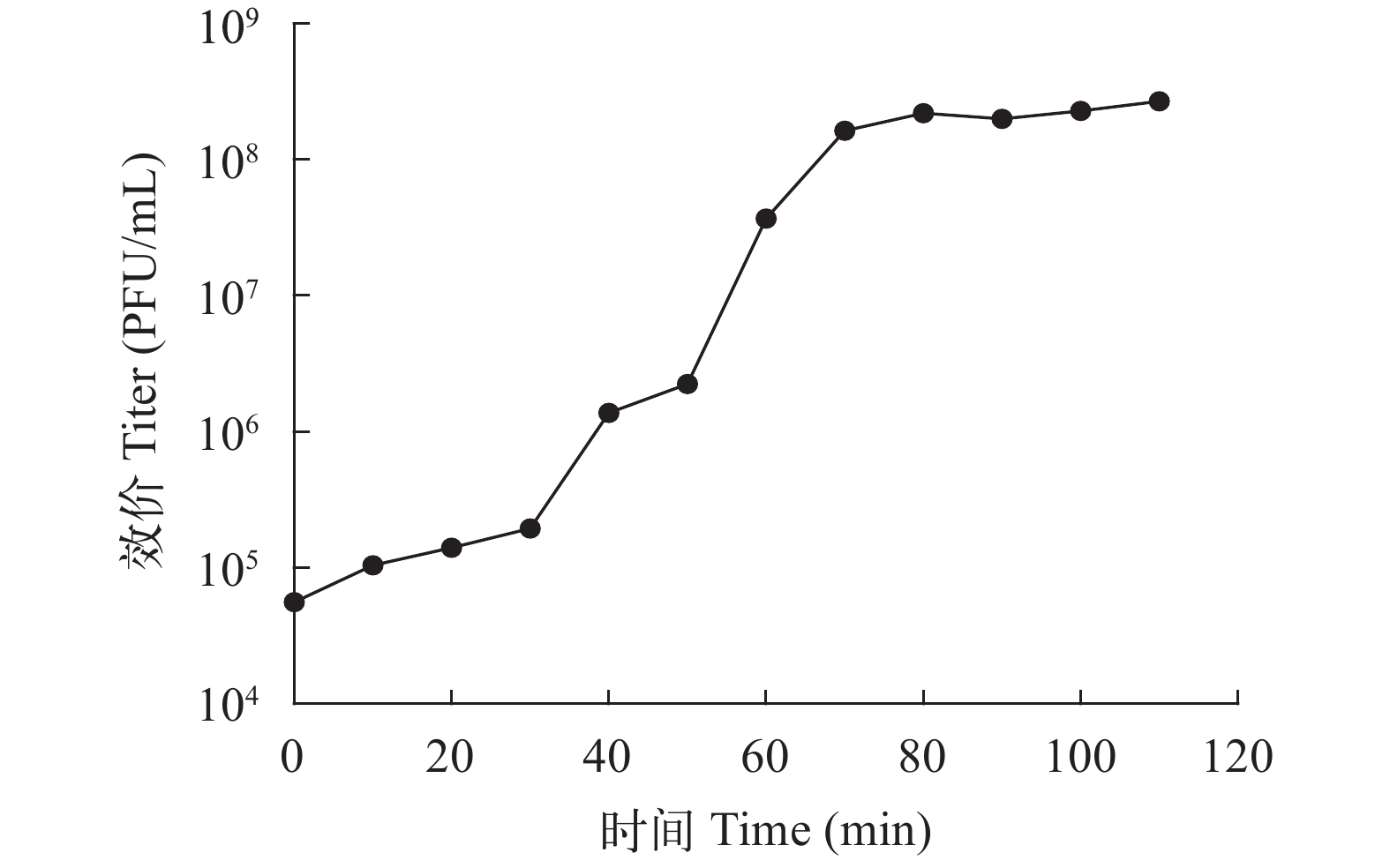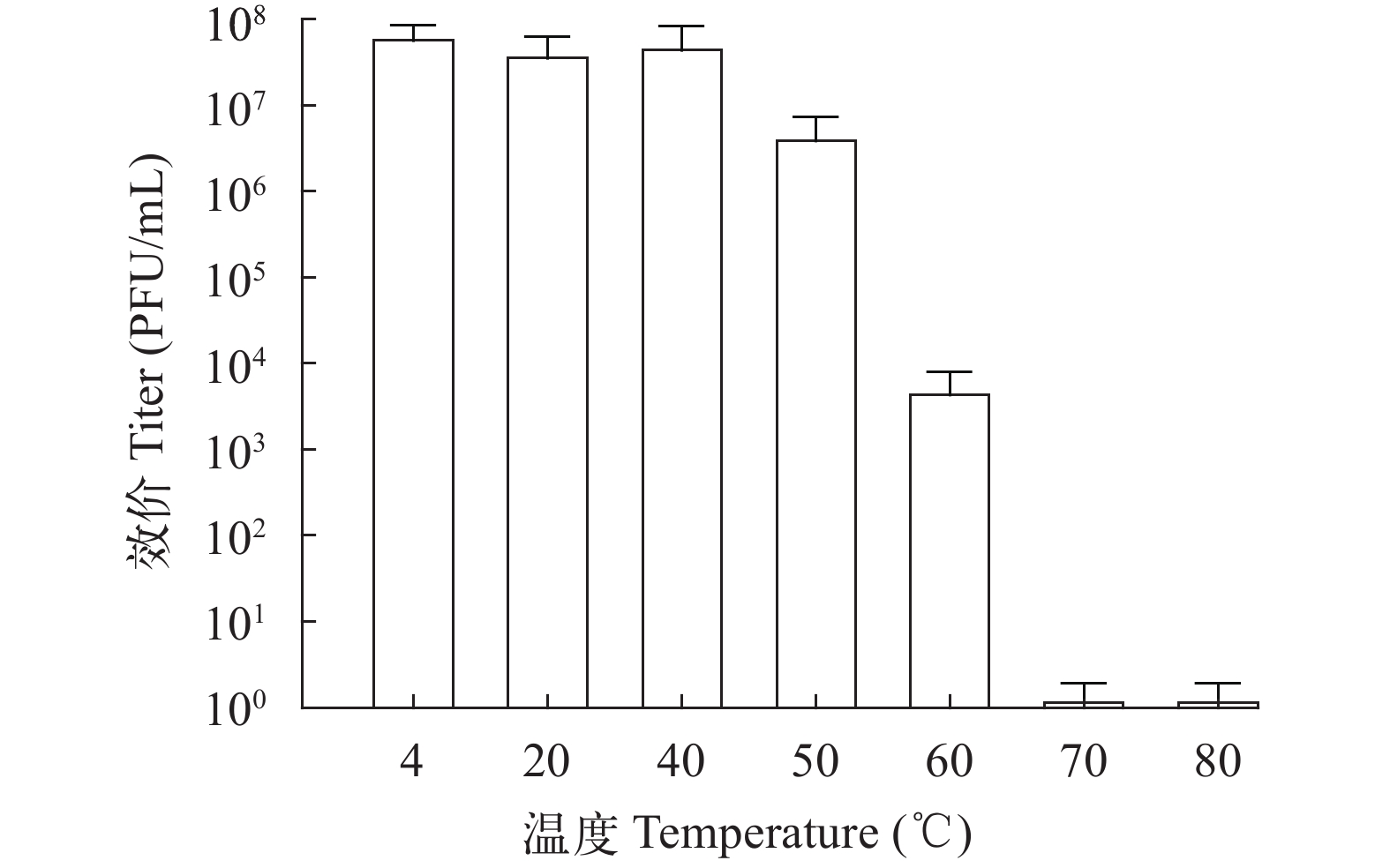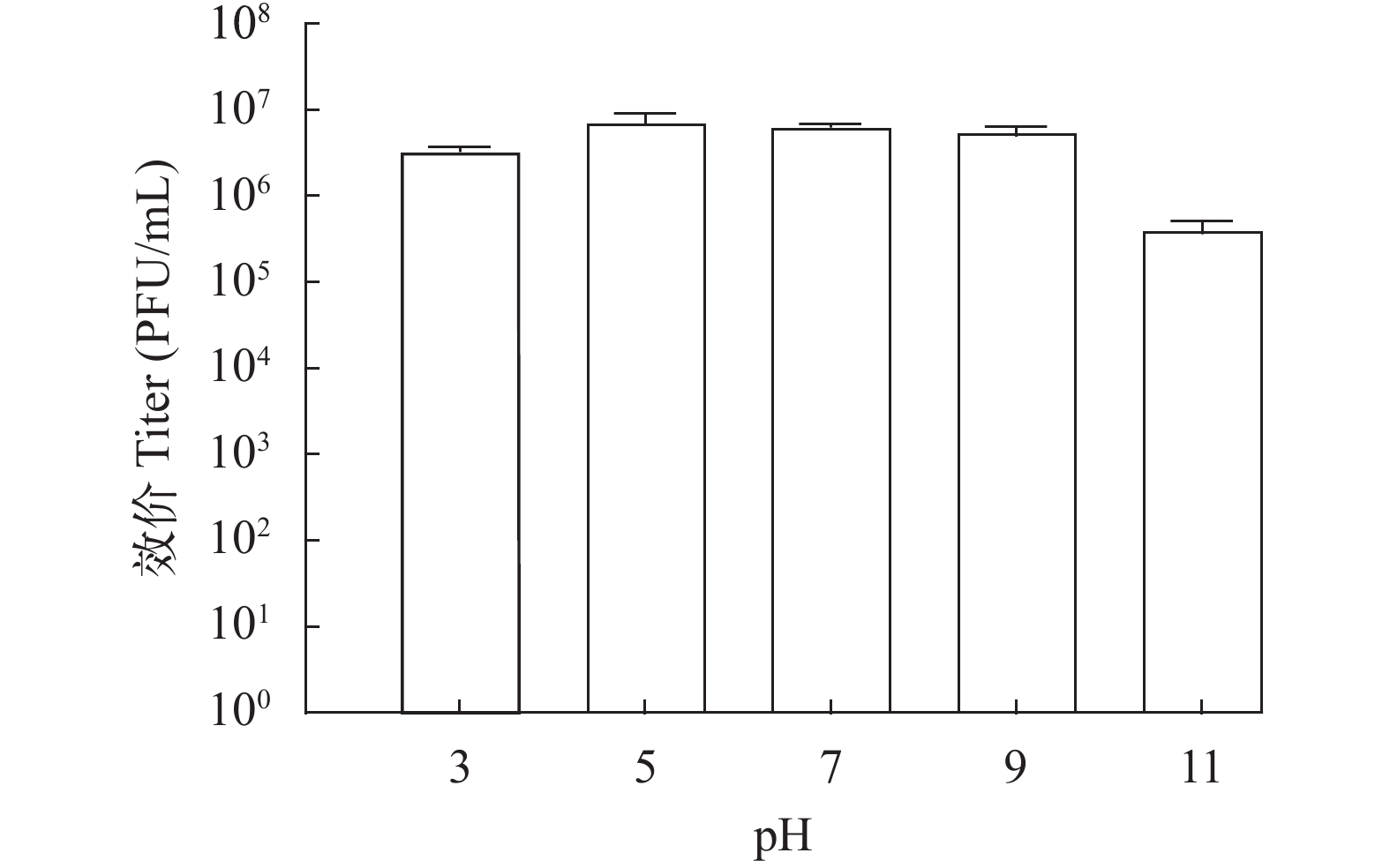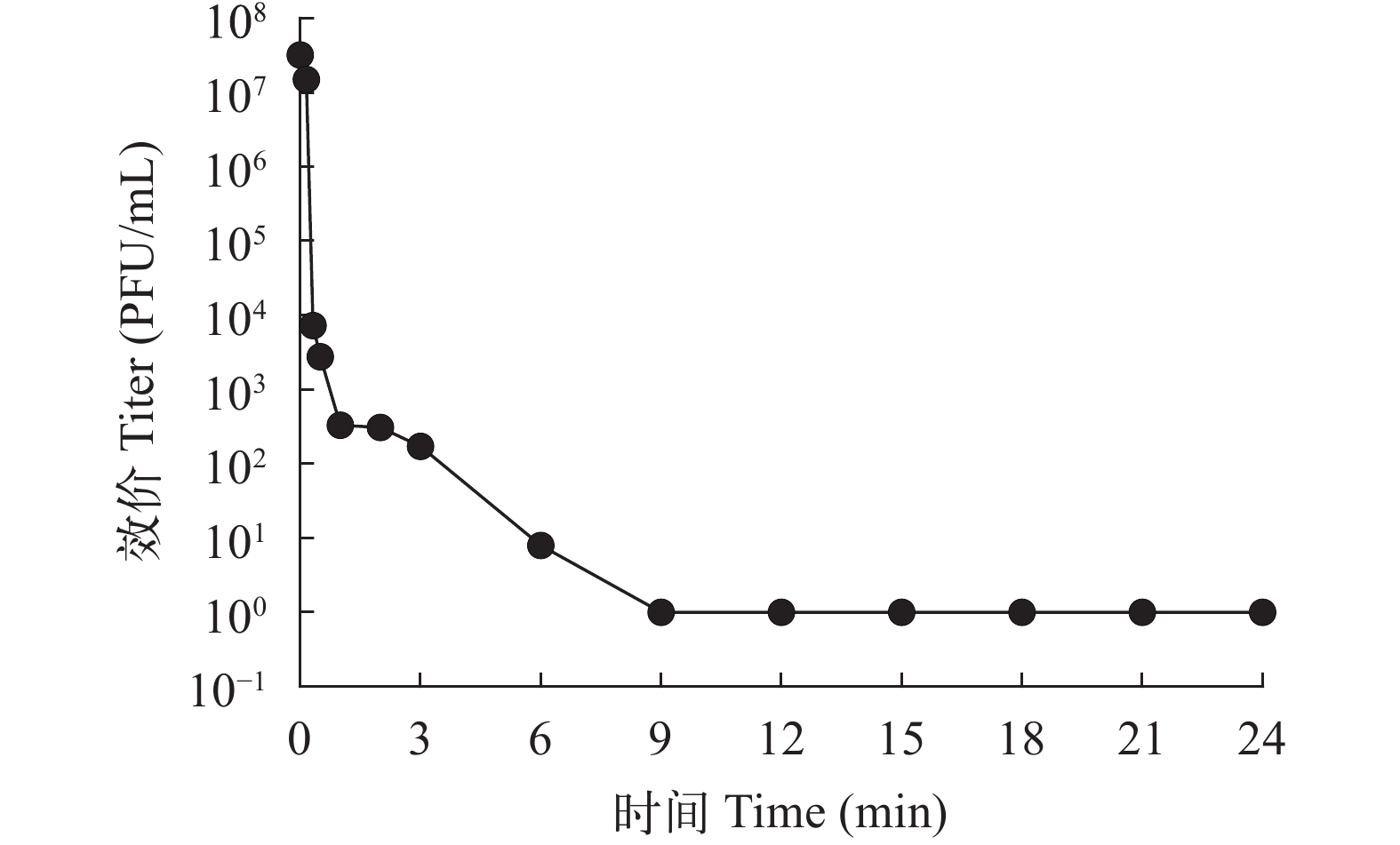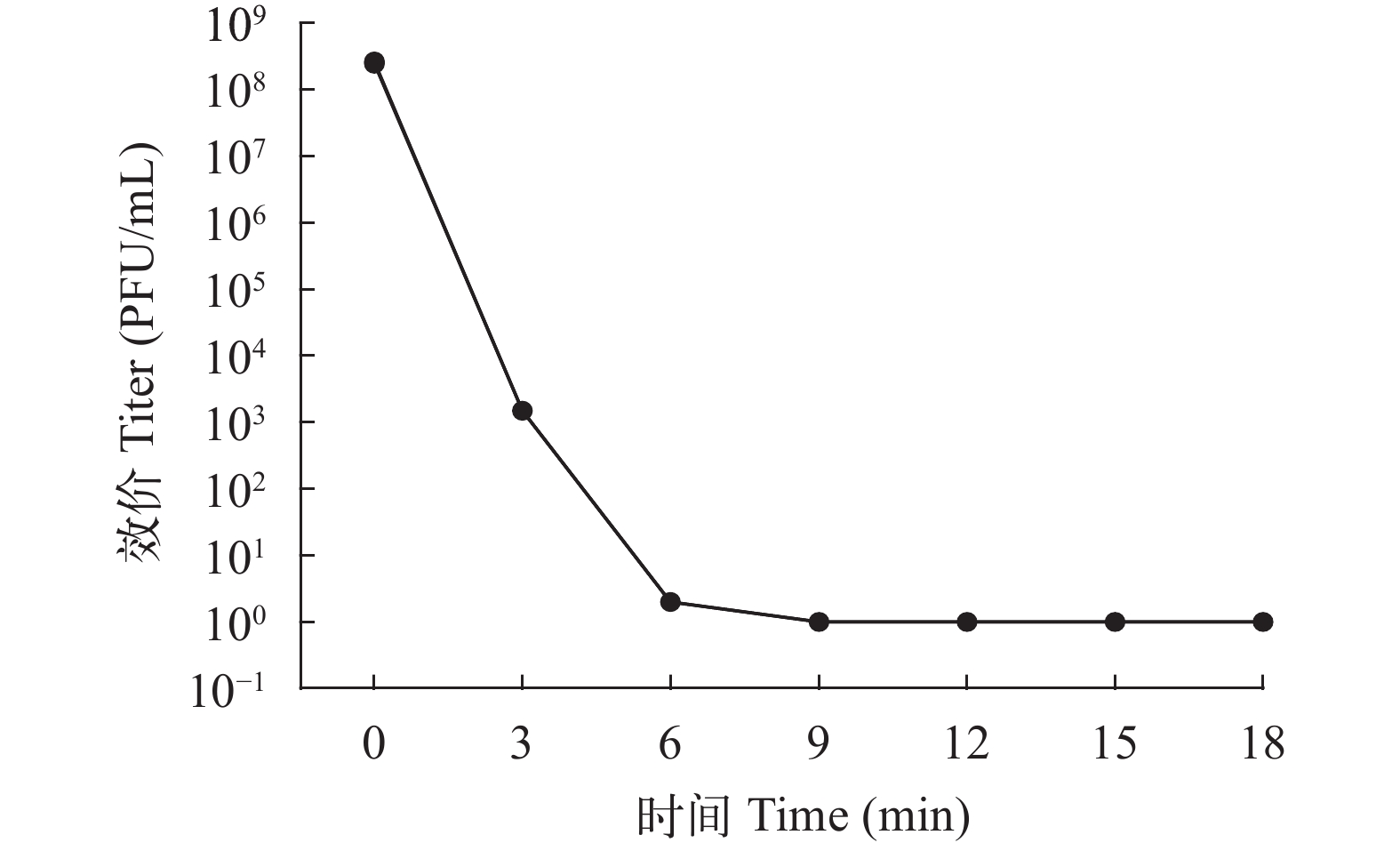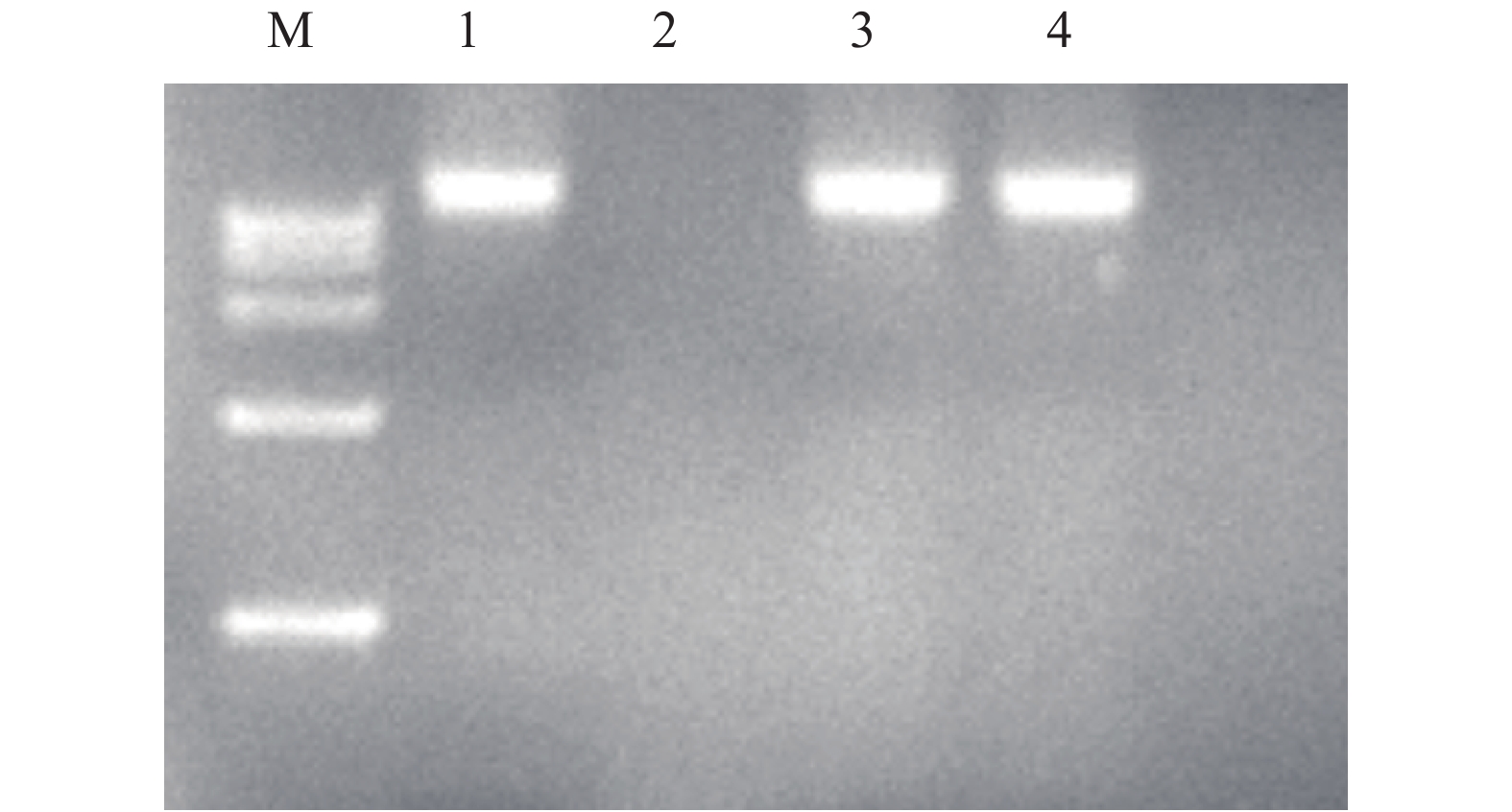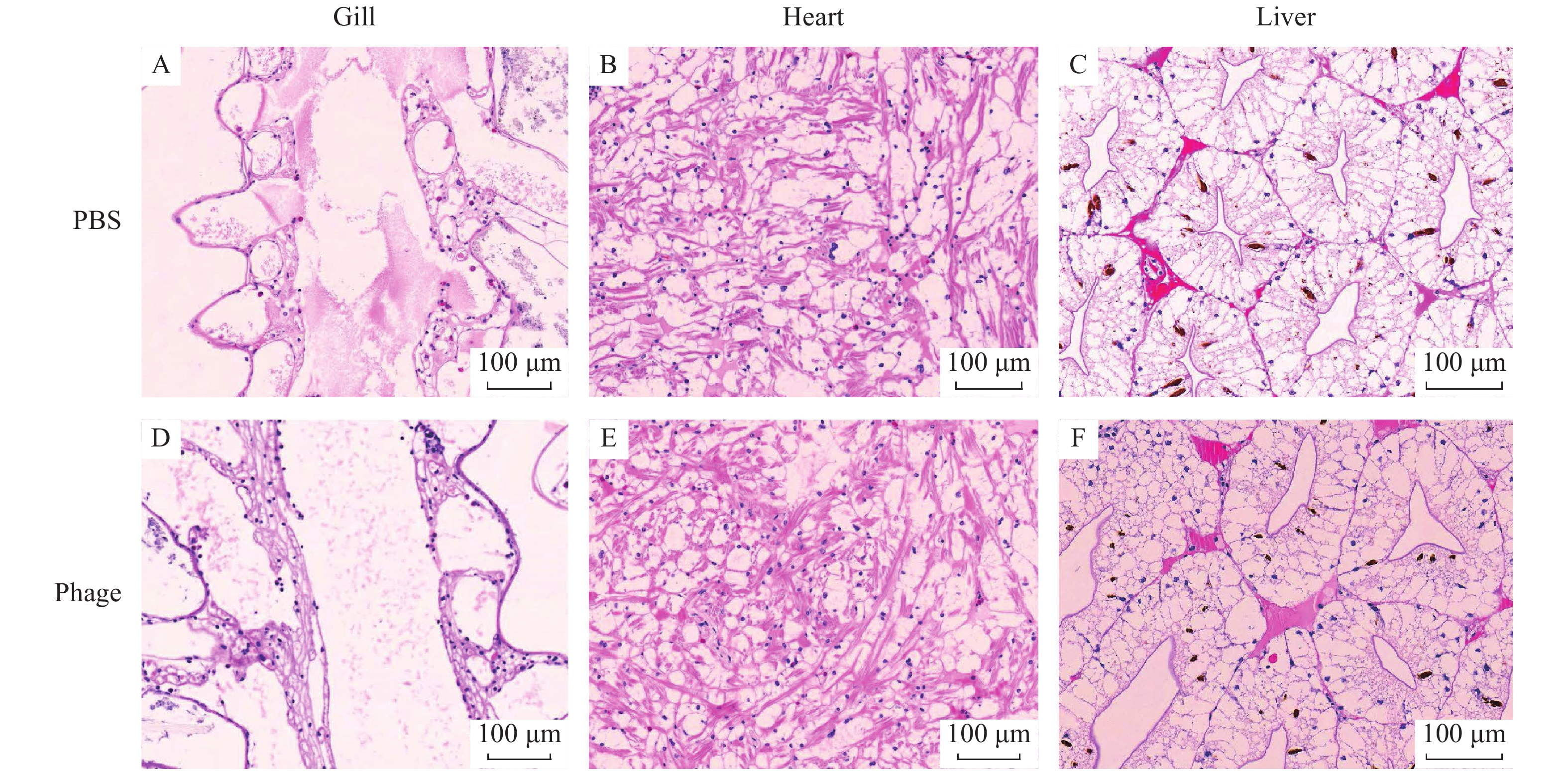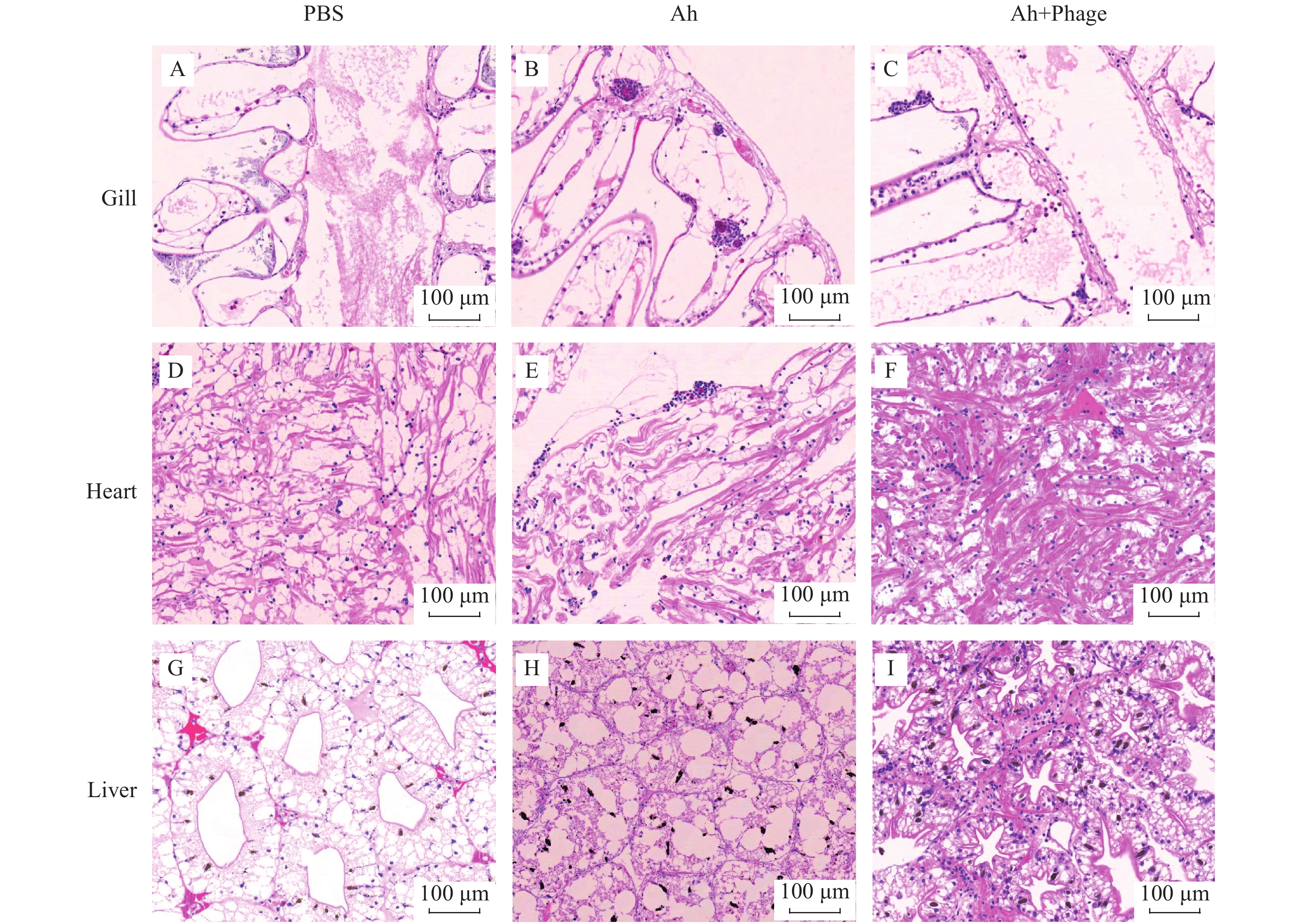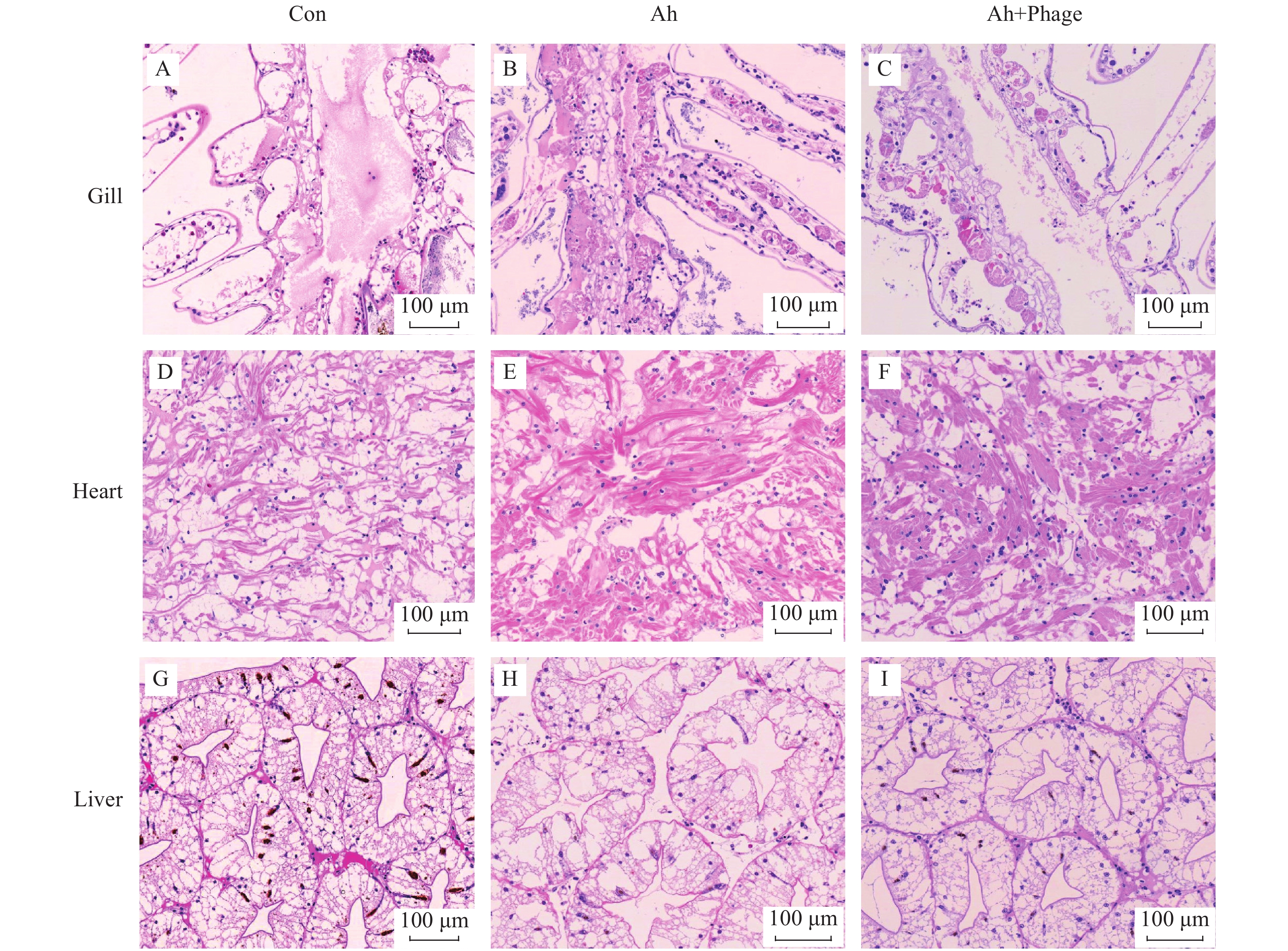ISOLATION, IDENTIFICATION AND PRELIMINARY APPLICATION OF AEROMONAS HYDROPHILA PHAGE FROM PROCAMBARUS CLARKII
-
摘要: 为分离获得致病性嗜水气单胞菌烈性噬菌体, 鉴定和研究其生物学特性, 为克氏原螯虾细菌性疾病的防治和治疗提供依据, 研究以患病克氏原螯虾分离到的致病性嗜水气单胞菌为宿主菌, 从湖泊水体中分离到多株噬菌体, 对其中一株烈性噬菌体Ph-0进行了生物学特性的分析, 包括噬菌斑形态的观察, 最佳感染复数的测定, 一步生长曲线的绘制, 热稳定性的测定等。结果显示, 噬菌体Ph-0的噬菌斑呈圆形, 边缘可见1 mm左右的半透明晕环; 其最佳感染复数为0.1 MOI; 一步生长曲线表明其潜伏期约20min, 裂解期持续约70min, 90min后为平台期; 噬菌体在0—40℃下活性无明显变化, 但是当温度高于50℃活性开始下降; 在pH 3—11的环境中活性良好, 具有耐酸耐碱的性质; 此外对紫外和氯仿极其敏感, 在处理数分钟后滴度下降明显。噬菌体治疗人工感染嗜水气单胞菌的克氏原螯虾试验结果表明, 分别采用注射和浸泡两种方法进行治疗, 保护率可分别达到66%和20%, 病理切片结果显示在使用噬菌体治疗之后, 克氏原螯虾的鳃、心脏和肝胰腺均得到不同效果的治疗, 总体效果良好。上述研究结果表明噬菌体Ph-0是一株裂解性较强, 裂解周期短的烈性噬菌体, 对感染嗜水气单胞菌的克氏原螯虾有一定的保护效果。Abstract: This study isolated and purified a virulent bacteriophage, named Ph-0, from lake by pathogenic Aeromonas hydrophila of Procambarus clarkii. The biological characteristics of the isolated bacteriophages were analyzed, including plaque morphology, the optimal multiplicity of infection, one-step growth curve, and thermal stability. The results showed that the plaque of phage Ph-0 was round with a semitransparent halo on the edge; the optimal multiplicity of infection was 0.1 MOI; the one-step growth curve showed that the incubation period of bacteriophage was about 20 minutes and the lytic period lasted about 70 minutes; the activity of bacteriophage had no obvious change from 0 to 40℃. The activity of bacteriophage did not change significantly between 0 and 40℃, but began to decrease at temperature above 50℃. It was stable in both acidic and alkaline environment, and the activity of bacteriophage was extremely sensitive to UV and chloroform. The results showed that the protective rates of injection and immersion were 66% and 20% respectively. The results of pathological sections showed that the gills, heart and hepatopancreas of Procambarus clarkii after phage treatment were greatly protected. The above results showed that bacteriophage Ph-0 is a bacteriophage with strong lytic ability and short lytic cycle, which has a certain protective effect on Procambarus clarkii.
-
纤毛虫作为地球上最古老的真核生物的一支, 无论是在其形态结构、行为方式还是在对环境的适应等方面, 均表现出其极大地多样性且与人类的生活环境息息相关[1]。纤毛虫在海水、淡水、土壤等微食物网中占有重要的生态地位, 可维持生态系统中有机物质的循环与能量流动, 在水质检测净化方面发挥着越来越重要的作用[2—6]。松花江水系为东北最大的淡水水系, 是大量鱼类、两栖动物、水生植物、无脊椎动物和微生物的栖息地。然而, 随着沿岸工农业生产发展、人口增加等原因, 沿江排放的各种污水导致河中各种有机污染物日益增多, 致使松花江水环境遭到严重污染, 河流中水生生物包括纤毛虫的种类日益减少, 然而目前松花江水域的纤毛虫区系尚不清楚。因此对松花江流域纤毛虫原生动物多样性的调查研究势在必行[7, 8]。
棘尾虫属(Stylonychia)隶属于纤毛门、多膜纲(Class Polyphymenophorea)、腹毛目(Hypotrichida)、尖毛虫科(Oxytrichidae), 该类纤毛虫高度特化, 体型偏大, 背腹扁平, 腹面具有棘毛, 该类群显著的特征是具有发达的口围带和波动膜。目前在本属下国际上已报道15种棘尾虫 [9—12]。国内目前发现并报道两种: 贻贝棘尾虫(Stylonychia mytilus)和浮萍棘尾虫(Stylonychia lemnae), 二者在体形、纤毛图式、皮层结构等形态方面极其相似[13]。贻贝棘尾虫作为棘尾虫属下的模式种, 食物通常为小型的原生动物, 常栖息于水质底部、运动、捕食[6]。鬃异源棘尾虫(Tetmemena pustulata) 隶属于异源棘尾虫属(Tetmemena), 该属由Eigner根据细胞发生学和分子系统学信息特征所建立, 鬃异源棘尾虫在形态学和细胞发生学方面均被报道过[14, 15]。草履虫属(Paramecium)隶属于寡膜纲(Oligohymenophorea), 膜口目(Hymenostmatida), 草履虫纲(Parameciidae), 以藻类、小型纤毛虫、细菌等为食的一类分布广泛的纤毛虫, 生活在海水、半咸水、淡水等生活环境中[15—19]。个体较大, 通常为长椭圆形、草履形等, 背腹扁平, 体纤毛紧密排列, 遍布全身, 大核椭圆形或肾形, 其繁殖能力较强[20]。榴弹虫属(Coleps)隶属于动基片纲(Kinetofragminophora)、前口目(Prostomatida), 该类纤毛虫通常体形呈椭球形、棒状或短棒状, 胞口恒位于体前端, 大核一枚, 体纤毛遍体分布, 其口纤毛器特化程度低, 胞口周围存在较多的辅助其进食的结构, 如胞口可发射的有毒丝泡。榴弹虫最明显的形态学鉴别特征为体表具有盔板带, 其盔板带的数目、盔板内窗口的类型等特征是该类群区分于其他类群的主要特征。
本工作对采自松花江中的4种淡水纤毛虫广布种——贻贝棘尾虫、鬃异源棘尾虫、尾草履虫(Paramecium caudatum) 和刚毛榴弹虫(Coleps hirtus) 的活体和纤毛图式进行了细致的形态学描述和报道, 其中贻贝棘尾虫为基于现代分类手段的重要重描述种, 而鬃异源棘尾虫为我国东北地区新记录种。研究结果为揭示东北松花江流域纤毛虫多样性区系提供了重要的数据支持。
1. 材料与方法
虫体培养: 贻贝棘尾虫、鬃异源棘尾虫、尾草履虫、刚毛榴弹虫均分离自哈尔滨市呼兰区的呼兰河(松花江支流)岸边的一农田池塘(45°93′87″N; 126°61′15″E), 采样日期为2016年9月19日, 样品采集地水温14℃。适当搅混取样处水体后, 将底质沉积物搅动起来形成悬浊液, 并采取少量腐败枝叶于采样瓶中带回实验室; 分别取采样地原位水于玻璃培养皿中(做好标记), 再分别加入3—4粒经沸水短时间高温煮过的米粒或麦粒, 加入虫体, 将培养皿至于室温下培养定期更换食物, 清理废物。
活体观察: 具体活体形态观察方法详见文献[21]。
氨银染色法、Wilbert之蛋白银法[22, 23]: 刚毛榴弹虫、尾草履虫采用氨银法染色, 贻贝棘尾虫、鬃异源棘尾虫采用Wilbert之蛋白银染色法 , 用以显示虫体的皮层及内部结构, 如纤毛下器、毛基体、核器及各种表膜下纤维系统等。文中名词术语参照文献[24]。
分类依据: Corliss J. O. 1979[25]。
2. 结果
2.1 贻贝棘尾虫的形态学描述(表 1; 图版 Ⅰ, 图版 Ⅱ)
表 1 贻贝棘尾虫、鬃异源棘尾虫形态特征统计Table 1. Morphometric characteristics of Stylonychia mytilus (first line) and Tetmemena pustulata (second line) specimens特征Character 最大值Max 最小值Min 平均值Mean 标准差SD 变异系数CV (%) 样本数n 体长 296 154 185 41.3 22.3 14 Body length (μm) 118 94 104.1 8.6 8.3 14 体宽 109 76 91.7 11.2 12.2 14 Body width (μm) 61 44 53.6 6.5 12.1 14 口区长 140 68 87.5 22.4 25.6 14 Buccal area length (μm) 58 40 48 4.7 9.8 14 口围带小膜数目 79 54 68 7.6 11.2 14 No. of adoral membranelle 43 29 34 4.0 11.8 14 额棘毛数目 8 8 8 0 0 14 No. of frontal cirri 8 8 8 0 0 14 腹棘毛数目 5 5 5 0 0 14 No. of ventral cirri 5 5 5 0 0 14 横棘毛数目 5 5 5 0 0 14 No. of transverse cirri 5 5 5 0 0 14 左缘棘毛数目 43 28 33 4.1 12.4 14 No. of left marginal row 20 15 18 2.8 15.6 14 右缘棘毛数目 51 38 44 3.9 8.9 14 No. of right marginal row 35 23 28 3.6 12.9 14 大核数目 2 2 2 0 0 14 No. of Macronuclear 2 2 2 0 0 14 ![]() 图版Ⅰ 贻贝棘尾虫活体照片1. 典型个体背面观, 示背侧灰色颗粒(箭头); 2—6. 背面观, 示不同个体体形; 3. 背面观, 示额棘毛(箭头); 4. 唇滴虫(箭头); 5. 背面观, 示大核(箭头); 6. 背面观, 示透明颗粒物(箭头), 伸缩泡(无尾箭头); 7, 8. 额棘毛; 9. 左缘棘毛(箭头); 10. 右缘棘毛(箭头); 11. 横棘毛(箭头); 12. 尾棘毛(箭头); 13, 14. 口围带; 15, 16. 伸缩泡(15中箭头所示); 比例尺=90 μm图版Ⅰ. Morphology of Stylonychia mytilus1. Dorsal view of typical individual with gray granules (arrow); 2—6. Dorsal views with different individuals shape; 3. Dorsal view with frontal cirri (arrow); 4. Chilomonas sp. (arrow); 5. Dorsal view with macronucleus (arrow); 6. Dorsal view with transparent particles (arrow) and contractile vacule (arrowhead); 7, 8. Frontal cirri; 9. Left marginal row (arrow); 10. Right marginal row (arrow); 11. Transverse cirri (arrow); 12. Caudal cirri (arrow); 13, 14. Adoral zone of membranelles; 15—16. Contractile vacuole (O: arrow). Scale bars=90 μm
图版Ⅰ 贻贝棘尾虫活体照片1. 典型个体背面观, 示背侧灰色颗粒(箭头); 2—6. 背面观, 示不同个体体形; 3. 背面观, 示额棘毛(箭头); 4. 唇滴虫(箭头); 5. 背面观, 示大核(箭头); 6. 背面观, 示透明颗粒物(箭头), 伸缩泡(无尾箭头); 7, 8. 额棘毛; 9. 左缘棘毛(箭头); 10. 右缘棘毛(箭头); 11. 横棘毛(箭头); 12. 尾棘毛(箭头); 13, 14. 口围带; 15, 16. 伸缩泡(15中箭头所示); 比例尺=90 μm图版Ⅰ. Morphology of Stylonychia mytilus1. Dorsal view of typical individual with gray granules (arrow); 2—6. Dorsal views with different individuals shape; 3. Dorsal view with frontal cirri (arrow); 4. Chilomonas sp. (arrow); 5. Dorsal view with macronucleus (arrow); 6. Dorsal view with transparent particles (arrow) and contractile vacule (arrowhead); 7, 8. Frontal cirri; 9. Left marginal row (arrow); 10. Right marginal row (arrow); 11. Transverse cirri (arrow); 12. Caudal cirri (arrow); 13, 14. Adoral zone of membranelles; 15—16. Contractile vacuole (O: arrow). Scale bars=90 μm![]() 图版Ⅱ 贻贝棘尾虫蛋白银染色照片(腹面观), 示纤毛图式1. 腹面观, 示大核, 小核(箭头); 2. 腹面观, 示额棘毛(箭头), 腹棘毛(无尾箭头); 3—5. 腹面观, 示口围带(箭头); 6. 腹面观, 示背触毛列(无尾箭头); 7. 口围带; 8. 小膜(箭头), 波动膜(无尾箭头); 9. 小核(箭头); 10. 细胞核; 11. 额棘毛; 12. 横棘毛(无尾箭头), 尾棘毛(箭头); 13. 右缘棘毛列; 14. 背面观, 示背触毛列(无尾箭头); 15. 左缘棘毛列; Ma=大核; 比例尺=90 μm图版Ⅱ. Morphology of Stylonychia mytilus after protargol impregnation (ventral views)1. Ventral view with macronucleus and Micronuleus (arrow). 2. Ventral view with frontal cirri (arrow) and ventral cirri (arrowhead); 3—5. Ventral views with adoral zone of membranelles (arrow); 6. Ventral view with dorsal kineties (arrowheads); 7. Adoral zone of membranelles; 8. Adoral zone of membranelles (arrow) and undulating membranes (arrowhead); 9. Micronuleus (arrow); 10. Macronucleus; 11. Frontal cirri; 12. Ventral cirri (arrowhead), caudal cirri (arrow); 13. Right marginal row; 14. Dosal view with dorsal kineties (arrowheads); 15. Left marginal row. Ma= macronucleus. Scale bars=90 μm
图版Ⅱ 贻贝棘尾虫蛋白银染色照片(腹面观), 示纤毛图式1. 腹面观, 示大核, 小核(箭头); 2. 腹面观, 示额棘毛(箭头), 腹棘毛(无尾箭头); 3—5. 腹面观, 示口围带(箭头); 6. 腹面观, 示背触毛列(无尾箭头); 7. 口围带; 8. 小膜(箭头), 波动膜(无尾箭头); 9. 小核(箭头); 10. 细胞核; 11. 额棘毛; 12. 横棘毛(无尾箭头), 尾棘毛(箭头); 13. 右缘棘毛列; 14. 背面观, 示背触毛列(无尾箭头); 15. 左缘棘毛列; Ma=大核; 比例尺=90 μm图版Ⅱ. Morphology of Stylonychia mytilus after protargol impregnation (ventral views)1. Ventral view with macronucleus and Micronuleus (arrow). 2. Ventral view with frontal cirri (arrow) and ventral cirri (arrowhead); 3—5. Ventral views with adoral zone of membranelles (arrow); 6. Ventral view with dorsal kineties (arrowheads); 7. Adoral zone of membranelles; 8. Adoral zone of membranelles (arrow) and undulating membranes (arrowhead); 9. Micronuleus (arrow); 10. Macronucleus; 11. Frontal cirri; 12. Ventral cirri (arrowhead), caudal cirri (arrow); 13. Right marginal row; 14. Dosal view with dorsal kineties (arrowheads); 15. Left marginal row. Ma= macronucleus. Scale bars=90 μm虫体的活体大小为(150—300) μm×(60—110) μm, 蛋白银染后大小为(260—350) μm×(110—250) μm, 长宽比约为2﹕1, 呈长椭圆形(图版 Ⅰ-1—6)。在活体观察时可见: 虫体通常在底部自由运动, 游动速度较快, 虫体有明显的背腹之分, 腹面较平滑, 背面较凸起, 呈灰色(图版 Ⅰ-1、2)。虫体内含有大量的透明颗粒以及灰色的不明颗粒物质, 通常情况下伸缩泡一枚, 呈圆形, 位于虫体腹面中部靠近右缘棘毛处, 直径大小为15—20 μm, 排空间歇为10—12s (图版 Ⅰ-6、15、16)。在虫体前端长有三根较粗、长的棘毛, 长30—50 μm, 辅助虫体捕食及运动; 在虫体背侧长有较粗的背触毛, 尾端长有三根较长的尾棘毛(长50—70 μm)(图版 Ⅰ-3、4、7、8、11、12)。虫体左右两侧各长有一列缘棘毛, 且右缘棘毛列比左缘棘毛列长, 左缘棘毛列由30—40根棘毛组成, 右缘棘毛列由40—50根棘毛组成, 长20—50 μm。贻贝棘尾虫的腹面和两侧的纤毛均特化成棘毛, 有助于虫体爬行、游泳、捕食等(图版 Ⅰ-9、10; 图版 Ⅱ-13、15)。活体观察时可看见虫体透明的, 椭圆形的大核, 小核难以观察(图版 Ⅰ-5)。经蛋白银染色后, 可清晰看见大核分为上下两核节, 分布于虫体上部的核节, 被口围带形成的半环所包围, 分布于虫体的下半部的核节, 呈椭圆形, 长约60 μm、宽约35 μm, 小核紧挨大核, 约3—5枚(图版 Ⅱ-1、9、10)。
贻贝棘尾虫口区约占虫体的1/2, 口围带发达, 呈问号状(图版 Ⅱ-3—5)。它是由口区小膜按照一定的顺序有规律的排列而成, 通常是从虫体的前部背侧弯曲后延伸至虫体的腹侧, 然后小膜宽度逐渐变窄, 直至收敛至胞口, 口围带通常由60—80片小膜组成(图版 Ⅱ-7、8)。额棘毛8枚, 呈椭圆形排列位于虫体前1/3处; 腹棘毛5枚, 呈3+2排列, 位于虫体中下部; 横棘毛5枚, 分布在尾部; 尾端为三枚尾棘毛(图版 Ⅱ-2、11、12)。共6列背触毛, 1—4列背触棘毛列弯曲幅度较大, 5—6列弯曲幅度较小, 其中背触棘毛列1、2、4列延伸至体末端(图版 Ⅱ-6、14)。口围带内侧具两条平行排列的波动膜, 分别是由横向排列的多个纤毛组成的膜状物, 可辅助虫体摄取食物(图版 Ⅱ-8)。
2.2 鬃异源棘尾虫的形态学描述(表 1、图版 Ⅲ、图版 Ⅳ)
![]() 图版 Ⅲ 鬃异源棘尾虫活体照片1. 典型个体腹面观; 2, 3. 腹面观, 示食物颗粒(无尾箭头); 4. 背面观, 伸缩泡(无尾箭头); 5. 背面观, 示背触棘毛(无尾箭头); 6. 背面观, 示口围带(无尾箭头); 7. 背面观; 8. 背面观, 示额棘毛(无尾箭头); 比例尺=55 μm图版 Ⅲ. Morphology of Tetmemena pustulata1. Ventral view of typical individual; 2, 3. Ventral views with food vacuoles (arrowhead); 4. Dorsal view with contractile vacuole (arrowhead); 5. Dorsal view with dorsal cirri (arrowhead); 6. Dorsal view with adoral zone of membranelles (arrowhead); 7. Dorsal view; 8. Dorsal view with frontal cirri (arrowhead). Scale bars=55 μm
图版 Ⅲ 鬃异源棘尾虫活体照片1. 典型个体腹面观; 2, 3. 腹面观, 示食物颗粒(无尾箭头); 4. 背面观, 伸缩泡(无尾箭头); 5. 背面观, 示背触棘毛(无尾箭头); 6. 背面观, 示口围带(无尾箭头); 7. 背面观; 8. 背面观, 示额棘毛(无尾箭头); 比例尺=55 μm图版 Ⅲ. Morphology of Tetmemena pustulata1. Ventral view of typical individual; 2, 3. Ventral views with food vacuoles (arrowhead); 4. Dorsal view with contractile vacuole (arrowhead); 5. Dorsal view with dorsal cirri (arrowhead); 6. Dorsal view with adoral zone of membranelles (arrowhead); 7. Dorsal view; 8. Dorsal view with frontal cirri (arrowhead). Scale bars=55 μm![]() 图版 Ⅳ 鬃异源棘尾虫的蛋白银染色照片1. 腹面观, 示腹棘毛(无尾箭头), 横棘毛(箭头); 2. 腹面观, 示额棘毛(无尾箭头), 大核; 3. 腹面观, 示左缘棘毛列(箭头), 右缘棘毛列(无尾箭头); 4—8. 发生的部分阶段, 4. 前仔虫腹面观, 无尾箭头示正解聚中的棘毛, 5—6. 中期新棘毛分化、迁移, 老波动膜解聚(箭头), 后仔虫新口围带(无尾箭头)形成, 7. 示分裂期的大核(无尾箭头), 8. 前仔虫波动膜(无尾箭头), 后仔虫波动膜(箭头); 9. 口围带(无尾箭头); 10. 额棘毛(无尾箭头), 小核(箭头); 11. 示大核(箭头), 小核; 12. 波动膜(无尾箭头); 13. 左缘棘毛列; Ma=大核; 比例尺=55 μm图版 Ⅳ. Morphology of Tetmemena pustulata after protargol staining1. Ventral view with ventral cirri (arrowhead) and transverse cirri (arrow); 2. Ventral view with frontal cirri (arrowhead) and macronucleus; 3. Ventral view with left marginal row (arrow) and right marginal row (arrowhead); 4—8. Several cell division stages. 4. Ventral view with the cirri in the depolymerization; 5—6. Medium-term cirri migration with undulating membranes depolymerization (arrow) and the new adoral zone of membranelles of opisthe (arrowhead); 7. Division period of macronucleus (arrowhead); 8. Proter undulate membranes (arrowhead) and opisthe undulate membranes (arrow); 9. Adoral zone of membranelles (arrowhead); 10. Frontal cirri (arrowhead) and micronuleus (arrow); 11. Macronucleus (arrow) and micronuleus; 12. Undulate membranes (arrowhead); 13. Left marginal row. Ma= macronucleus. Scale bars=55 μm
图版 Ⅳ 鬃异源棘尾虫的蛋白银染色照片1. 腹面观, 示腹棘毛(无尾箭头), 横棘毛(箭头); 2. 腹面观, 示额棘毛(无尾箭头), 大核; 3. 腹面观, 示左缘棘毛列(箭头), 右缘棘毛列(无尾箭头); 4—8. 发生的部分阶段, 4. 前仔虫腹面观, 无尾箭头示正解聚中的棘毛, 5—6. 中期新棘毛分化、迁移, 老波动膜解聚(箭头), 后仔虫新口围带(无尾箭头)形成, 7. 示分裂期的大核(无尾箭头), 8. 前仔虫波动膜(无尾箭头), 后仔虫波动膜(箭头); 9. 口围带(无尾箭头); 10. 额棘毛(无尾箭头), 小核(箭头); 11. 示大核(箭头), 小核; 12. 波动膜(无尾箭头); 13. 左缘棘毛列; Ma=大核; 比例尺=55 μm图版 Ⅳ. Morphology of Tetmemena pustulata after protargol staining1. Ventral view with ventral cirri (arrowhead) and transverse cirri (arrow); 2. Ventral view with frontal cirri (arrowhead) and macronucleus; 3. Ventral view with left marginal row (arrow) and right marginal row (arrowhead); 4—8. Several cell division stages. 4. Ventral view with the cirri in the depolymerization; 5—6. Medium-term cirri migration with undulating membranes depolymerization (arrow) and the new adoral zone of membranelles of opisthe (arrowhead); 7. Division period of macronucleus (arrowhead); 8. Proter undulate membranes (arrowhead) and opisthe undulate membranes (arrow); 9. Adoral zone of membranelles (arrowhead); 10. Frontal cirri (arrowhead) and micronuleus (arrow); 11. Macronucleus (arrow) and micronuleus; 12. Undulate membranes (arrowhead); 13. Left marginal row. Ma= macronucleus. Scale bars=55 μm虫体的活体大小为(90—120) μm×(45—60) μm, 长宽比约为2﹕1。体形为长椭圆形、背腹扁平, 虫体呈浅灰色, 靠近虫体尾端部分含灰黑色颗粒, 直径大小2 μm(图版 Ⅲ-1、2)。活体观察时可见细胞内质中含有大量球形颗粒, 其直径大小为1.0—4.5 μm, 且具一明显的伸缩泡, 位于虫体腹部中部, 直径大小为8—10 μm, 排空间歇不定(图版 Ⅲ-3、4)。虫体近尾端背部长有5根特化棘毛, 长度为15—26 μm(图版 Ⅲ-5、7)。
纤毛图式如图版 Ⅳ所示, 具发达的口围带和波动膜, 前者起始于虫体前端并后行绕至腹面, 约占虫体长1/2, 每个虫体口围带由约36片小膜组成, 每片小膜长4—8 μm, 波动膜长约60 μm(图版 Ⅲ-5、6; 图版 Ⅳ-9、12)。大核2枚, 分别位于体前端1/3和体后端1/3处, 呈椭圆形, 大小约为40 μm×15 μm; 小核两至多枚, 圆形, 直径约为6 μm(图版 Ⅳ-2、9—11)。左缘棘毛列含约28—43根棘毛, 右缘棘毛列含约38—51根棘毛, 右缘棘毛列明显长于左缘棘毛列(图版 Ⅳ-3、13)。额棘毛8根, 腹棘毛5根(3+2), 分布于虫体中下部; 横棘毛5根, 分布于虫体近尾端(图版 Ⅳ-1、2、10)。如图版 Ⅳ-4—8, 为鬃异源棘尾虫几个代表性发生时期, 在发生早期, 前仔虫中的口棘毛、额腹棘毛发生解聚, 且额腹棘毛解聚并发育成为前仔虫的原基Ⅰ和原基Ⅱ, 形成5列棘毛原基(图版 Ⅳ-4、5)。老的波动膜前1/3在发生早期会发生解聚, 后2/3保持不变, 当原位重建后其新形成的部分和未发生变化的部分重新拼接成前仔虫的波动膜(图版 Ⅳ-5、8)。后仔虫的口区小膜从早期就开始出现演化, 在口后腹棘毛左侧出现毛基体群, 随着发生阶段的进行, 口原基由上至下, 小膜由右至左依次组装, 合成后仔虫新的口区(图版 Ⅳ-5、6)。当发生从中期进入末期时, 大核经过融合, 已经再次分裂, 原始各棘毛原基也分化成前、后仔虫新的结构(图版 Ⅳ-7、8)。
2.3 尾草履虫的形态学描述(表 2、图版 Ⅴ)
表 2 尾草履虫、刚毛榴弹虫形态特征统计Table 2. Morphometric characteristics of Paramecium caudatum (first line) and Coleps hirtus (second line) specimens特征Character 最大值Max 最小值Min 平均值Mean 标准差SD 变异系数CV (%) 样本数n 体长 249 144 185.7 32.9 17.7 14 Body length (μm) 75 44 57.8 9.8 17.0 14 体宽 100 46 81 18.8 23.2 14 Body width (μm) 50 20 32.4 9.8 30.2 14 大核数目 1 1 1 0 0 14 No. of Macronuclear 1 1 1 0 0 14 大核长 74 48 61.2 7.7 12.6 14 Macronuclear length (μm) 10 7 8.2 1.2 14.6 14 大核宽 35 22 29.6 4.4 14.9 14 Marconuclear width (μm) 10 7 8.2 1.2 14.6 14 体动基列数目 135 95 114 12.2 10.7 14 No. of somatic kineties 16 14 14.8 0.9 6.1 14 口区小膜数目 3 3 3 0 0 14 No. of membranelle 0 0 0 0 14 口侧膜原基数目 0 0 0 0 0 14 No. of Adoral organelle 3 3 3 0 0 14 ![]() 图版 Ⅴ 尾草履虫活体(1—10)和氨银法染色所得的纤毛图式照片(11—18)1—5. 腹面观, 示不同个体体形; 1. 伸缩泡(箭头); 3. 射出体(箭头); 4. 大核(箭头); 5. 内含物(箭头); 6. 伸缩泡; 7. 口(箭头); 8, 9. 伸缩泡, 收集管(箭头); 10. 射出体(箭头); 11, 12. 腹面观, 染色后虫体纤毛图式; 13. 口前缝合线(箭头); 14. 咽膜(箭头); 15. 口后缝合线(箭头); 16, 18. 体动基列; 17. 大核; Ma=大核; 比例尺=90 μm图版 Ⅴ. Paramecium caudatum (1—10) and silver carbonate staining (11—18)1—5. Ventral views with different individuals shape; 1. Contractile vacuole (arrow); 3. Extrusome (arrow); 4. Macronucleus (arrow); 5. Inclusions (arrow); 6. Contractile vacuole; 7. Buccal apparatus (arrow); 8, 9. Contractile vacuole and collecting canals (arrow); 10. Extrusome (arrow); 11, 12. Ventral view of Infraciliature; 13. Buccal apparatus with preoral suture line (arrow); 14. Peniculus (arrow); 15. Postoral suture line (arrow); 16, 18. Somatic kineties; 17. Macronucleus. Ma=macronucleus. Scale bars=90 μm
图版 Ⅴ 尾草履虫活体(1—10)和氨银法染色所得的纤毛图式照片(11—18)1—5. 腹面观, 示不同个体体形; 1. 伸缩泡(箭头); 3. 射出体(箭头); 4. 大核(箭头); 5. 内含物(箭头); 6. 伸缩泡; 7. 口(箭头); 8, 9. 伸缩泡, 收集管(箭头); 10. 射出体(箭头); 11, 12. 腹面观, 染色后虫体纤毛图式; 13. 口前缝合线(箭头); 14. 咽膜(箭头); 15. 口后缝合线(箭头); 16, 18. 体动基列; 17. 大核; Ma=大核; 比例尺=90 μm图版 Ⅴ. Paramecium caudatum (1—10) and silver carbonate staining (11—18)1—5. Ventral views with different individuals shape; 1. Contractile vacuole (arrow); 3. Extrusome (arrow); 4. Macronucleus (arrow); 5. Inclusions (arrow); 6. Contractile vacuole; 7. Buccal apparatus (arrow); 8, 9. Contractile vacuole and collecting canals (arrow); 10. Extrusome (arrow); 11, 12. Ventral view of Infraciliature; 13. Buccal apparatus with preoral suture line (arrow); 14. Peniculus (arrow); 15. Postoral suture line (arrow); 16, 18. Somatic kineties; 17. Macronucleus. Ma=macronucleus. Scale bars=90 μm虫体的活体大小约(150—250) μm×(60—100) μm, 长宽比约为2﹕1(图版 Ⅴ-1—5)。活体观察时可见: 虫体呈卵圆形或草鞋底形, 其横截面为椭圆形, 虫体前端稍尖, 后端较钝圆, 形状较稳定, 虫体浅灰色(图版 Ⅴ-1、2)。在水中常常以身体纵轴为轴旋转向前运动, 有时自由运动, 速度较快, 虫体纤毛长6—8 μm, 其皮层下射出体较发达, 均匀有规律排布于皮膜下方, 射出体呈短棒状, 长为7—8 μm(图版 Ⅴ-3、7)。大核一枚, 呈长椭圆形, 位于虫体的1/2—2/3处, 长约为60 μm, 宽约为40 μm (图版 Ⅴ-4、11、17)。虫体内含有大量的内含物、食物泡、晶体、不明食物颗粒, 其位置不固定, 可自由移动(图版 Ⅴ-5)。伸缩泡2枚, 分别位于腹面体前端1/3和体后端1/3处, 直径约为10 μm, 2个伸缩泡交替伸缩, 排空间歇不固定, 6—10次/min, 收集管相对较发达, 每枚伸缩泡连接7—8条收集管(图版 Ⅴ-1、6、8、9)。口区位于体中部, 向内凹陷, 直至胞口处, 其口区含有三片咽膜, 每片咽膜由4列毛基粒组成, 其口前缝合线和口后缝合线明显(图版 Ⅴ-7、13—15)。体纤毛排列紧密, 体动基列95—135列(图版 Ⅴ-12、16、18)。
2.4 刚毛榴弹虫形态学描述(表 2、图版 Ⅵ)
![]() 图版 Ⅵ 刚毛榴弹虫活体(1—11)和氨银法染色所得照片(12—15)1. 典型个体, 示虫体尾端棘刺(无尾箭头), 伸缩泡(箭头); 2—7. 示不同个体体形; 3. 示体纤毛(箭头), 5. 示色素颗粒(箭头), 7. 示内含物(无尾箭头), 体纤毛(箭头); 8. 虫体盔板; 9. 虫体盔板, 棘刺(箭头); 10. 局部盔板, 脊(箭头); 11. 棘刺(箭头); 12. 体动基列(箭头); 13. 大核, 口区(箭头); 14. 二分裂, 示小核(箭头); 15. 围口纤毛列(箭头); Ma=大核, 比例尺=30 μm图版 Ⅵ. Coleps hirtus (1—11) and silver carbonate staining (12—15)1. The end of the body cirri (arrowhead) and contractile vacucle (arrow); 2—7. Different individuals shape; 3. Somatic cilia (arrow); 5. Pigment particles (arrow); 7. Contents (arrowhead) and somatic cilia (arrow); 8. Armour plate; 9. Armour plates and spines (arrow); 11. Spines (arrow); 12. Somatic kineties (arrow); 13. Macronucleus with buccal field (arrow); 14. Division period with micronuleus (arrow); 15. Perioral ciliary (arrows). Ma =macronucleus. Scale bars=30 μm
图版 Ⅵ 刚毛榴弹虫活体(1—11)和氨银法染色所得照片(12—15)1. 典型个体, 示虫体尾端棘刺(无尾箭头), 伸缩泡(箭头); 2—7. 示不同个体体形; 3. 示体纤毛(箭头), 5. 示色素颗粒(箭头), 7. 示内含物(无尾箭头), 体纤毛(箭头); 8. 虫体盔板; 9. 虫体盔板, 棘刺(箭头); 10. 局部盔板, 脊(箭头); 11. 棘刺(箭头); 12. 体动基列(箭头); 13. 大核, 口区(箭头); 14. 二分裂, 示小核(箭头); 15. 围口纤毛列(箭头); Ma=大核, 比例尺=30 μm图版 Ⅵ. Coleps hirtus (1—11) and silver carbonate staining (12—15)1. The end of the body cirri (arrowhead) and contractile vacucle (arrow); 2—7. Different individuals shape; 3. Somatic cilia (arrow); 5. Pigment particles (arrow); 7. Contents (arrowhead) and somatic cilia (arrow); 8. Armour plate; 9. Armour plates and spines (arrow); 11. Spines (arrow); 12. Somatic kineties (arrow); 13. Macronucleus with buccal field (arrow); 14. Division period with micronuleus (arrow); 15. Perioral ciliary (arrows). Ma =macronucleus. Scale bars=30 μm虫体活体大小为(40—75) μm×(23—50) μm, 长宽比约为3﹕2, 虫体体形通常相对稳定, 在不同个体间稍有差别, 呈现为长椭圆形, 长卵圆形或圆柱状, 无明显的背腹之分, 虫体呈深灰色(图版 Ⅵ-1—7)。细胞质含大量食物泡及色素颗粒(图版 Ⅵ-4、5、7、9)。虫体运动时多数以虫体的纵轴为轴旋转向前游动, 或是呈S形向前运动, 速度较快, 通常在相对污浊的水环境中数量较多。虫体口区恒位于虫体的最前端, 呈圆形, 其口直径约为10 μm (图版 Ⅵ-15)。伸缩泡单一, 通常位于虫体亚尾端; 大核一枚, 近圆形, 其直径7—10 μm, 通常位于虫体中部, 小核紧邻大核(图版 Ⅵ-1、7、12、13、14)。
盔板带共有6圈, 分别为围口盔板带、顶端盔板带、前主盔板带、后主盔板带、亚尾端盔板带、尾端盔板带, 每圈约有14块无色长方形盔板组成(图版 Ⅵ-8、9)。刚毛榴弹虫盔板为双孔形盔板, 肾形。活体观察中虫体前端具有明显的平截区, 在尾端盔板带上长有两根较粗的棘刺, 长2—3 μm(图版 Ⅵ-1、9、11、13)。围口盔板带顶端逐渐变尖, 尾端盔板带末端逐渐变尖, 呈刺状, 其窗口数目较为恒定(图版 Ⅵ-8、9)。顶端盔板带有一逐渐变尖的末端, 使虫体顶端平截, 呈皇冠状, 个别盔板上着生有明显的顶刺。前主盔板带、后主盔板带, 亚尾端盔板带均具有四行窗口(图版 Ⅵ-7—9)。在每两个主盔板带结合的地方, 虫体宽度稍稍变窄, 每列盔板中脊较发达, 每一肾形窗口右侧具脊, 左侧边缘较平滑(图版 Ⅵ-10)。
口区开口于顶端。围绕口的动基列环是由多对成对的毛基体所组成, 三个斜向口器靠近围口纤毛环。口器Ⅰ有三对毛基粒组成, 口器ⅡⅢ 由四对毛基粒组成, 通常活体下难于观察, 口围篮由内口围篮与外口围篮组成。体纤毛均匀排布, 长6—7 μm (图版 Ⅵ-3、7)。体动基列通常约为14列, 比较稳定(图版 Ⅵ-12、13)。繁殖方式为典型的二分裂(图版 Ⅵ-14)。
3. 讨论
本工作报道的贻贝棘尾虫哈尔滨种群和Ehrenberg[37]报道的原始种群及史新柏[16]所报道的种群相比, 形态特征基本吻合: 虫体大小均约为200 μm×100 μm, 均具有发达的口区小膜, 6列背触毛的排列方式相同。细微区别在于哈尔滨种群口围带平均由70片小膜组成, 而原始种群约60片小膜; 前者小核数目3—5枚, 后者1—7枚; 此外, 本工作对哈尔滨贻贝棘尾虫的左右缘棘毛组成数目进行了补足性描述。
国内对鬃异源棘尾虫该种报道过4次, 哈尔滨种群、武汉东湖种群、珠江种群和漠河种群, 其中漠河种群在形态及其发生方面描述较详细, 且采样地点与本文报道种群相近, 在此对2个种群进行比较如下[26—28]。本文报道的鬃异源棘尾虫哈尔滨种群与Luo等[29]报道的鬃异源棘尾虫漠河种群相比, 二者在运动、体形、棘毛排列方式及数目上完全一致; 构成口围带的小膜数目、口区长度均为50 μm左右; 伸缩泡位置、大小、内质颗粒大小相近; 二者之间区别在于哈尔滨鬃异源棘尾虫的左右缘棘毛数目普遍多于漠河鬃异源棘尾虫的数目, 前者左/右缘棘毛数约为18/28, 后者左/右缘棘毛数约为17/24; 前者小核数目两至多枚, 后者小核数目普遍为两枚; 前者成虫虫体大小较稳定, (95—118) μm×(45—61) μm, 后者(45—125) μm×(25—85) μm, 波动范围较大; 在发生模式上, 哈尔滨鬃异源棘尾虫与漠河种群遵循同一种发生模式。哈尔滨鬃异源棘尾虫作为异源棘尾虫属的模式种与棘尾虫属的模式种贻贝棘尾虫相比, 前者在体形上前后端均钝圆, 后者前端明显宽于尾端; 前者横棘毛呈J形, 后者横棘毛则分为两组。
尾草履虫为纤毛虫一著名常见类群, 但基于现代分类学染色技术的尾草履虫的形态学的详细报道较少, 提供完备分类学信息仅见于潘旭明[30]描述的青岛种群(发现于青岛崂山淡水湖), 本文报道的哈尔滨尾草履虫种群与其相比, 共同点为二者2枚伸缩泡均分布于虫体的两端, 虫体体形、大小相近, 体动基列数均约为100; 皮层下射出体排列密集, 均呈短棒状。不同点在于, 本文报道的尾草履虫每枚伸缩泡连接7—8条收集管, 后者收集管数为10条; 初步预测因两种尾草履虫生活环境、地理位置等条件不同, 从而导致尾草履虫两种群特征的细微差别, 但具体原因有待于下一步的深入研究。将同属的绿草履虫与其相比, 尾草履虫体型略大[活体(150—250) μm×(60—100) μm vs. (70—110) μm×(40—55) μm], 体动基列较多(95—135 vs. 70—85), 且活体观察时绿草履虫可见虫体内部含有大量绿色颗粒物质, 故种间差异较显著[30]。
本文榴弹虫与前人报道的刚毛榴弹虫相比, 均具6圈盔板带, 且前主盔板带、后主盔板带均为4行, 每行盔板数14—16; 顶端盔板带和亚尾端盔板带均为2行, 以细菌、微小原生动物、藻类等为食; 体动基列数目相近, 约14列, 具有棘状突起, 其盔板窗口均是双窗口型盔板, 因此将本文榴弹虫定为刚毛榴弹虫[31—33]。且与Smith等[34]报道的美国种群、Bahatia[35]的印度种群及Perty等[36]的瑞士种群报道的刚毛榴弹虫相比, 后者无棘状突起。
-
图 7 噬菌体Ph-0基因组琼脂糖凝胶电泳图
M. DL15000 marker; 1. 噬菌体Ph-0核酸; 2. 经DNase I酶切的噬菌体核酸; 3. 经RNase A酶切的噬菌体核酸; 4. 经Mung Bean Nuclease酶切的噬菌体核酸
Figure 7. Agarose gel electrophoresis of Ph-0 genomic
M. DL15000 marker; 1. Genome of phage Ph-0; 2. Digestion of nucleic acid by DNase I; 3. Digestion of nucleic acid by RNase A; 4. Digestion of nucleic acid by Mung Bean Nuclease
图 8 克氏原螯虾注射噬菌体Ph-0后的组织切片观察结果
A. 对照组鳃; B. 对照组心; C. 对照组肝胰腺; D. 噬菌体组鳃; E. 噬菌体组心; F. 噬菌体组肝胰腺
Figure 8. Tissue section observation of Procambarus clarkii after injection of phage Ph-0
A. Gill of control; B. Heart of control; C. Liver of control; D. Gill of phage group; E. Heart of phage group; F. Liver of phage group
图 10 组织切片观察结果
A. 对照组鳃; B. 注射细菌组鳃; C. 治疗组鳃; D. 对照组心; E. 注射细菌组心; F. 治疗组心; G. 对照组肝胰腺; H. 注射细菌组肝胰腺; I. 治疗组肝胰腺
Figure 10. Observation results of tissue sections
A. Gill of negative control; B. Gill of Ah group; C. Gill of treatment group; D. Heart of negative control; E. Heart of Ah group; F. Heart of treatment group; G. Liver of negative group; H. Liver of Ah group; I. Liver of treatment group
图 12 组织切片观察结果
A. 对照组鳃; B. 注射细菌组鳃; C. 治疗组鳃; D. 对照组心; E. 注射细菌组心; F. 治疗组心; G. 对照组肝胰腺; H. 注射细菌组肝胰腺; I. 治疗组肝胰腺
Figure 12. Observation results of tissue sections
A. Gill of negative control; B. Gill of Ah group; C. Gill of treatment group; D. Heart of negative control; E. Heart of Ah group; F. Heart of treatment group; G. Liver of negative group; H. Liver of Ah group; I. Liver of treatment group
表 1 噬菌体Ph-0的最佳感染复数
Table 1 The optimal MOI of phage Ph-0
序号No. 感染复数(MOI) 菌落总数(CFU/mL) 滴度(PFU/mL) 噬菌体滴度(PFU/mL) 1 100 1×107 1×109 1.35×105 2 10 1×107 1×108 2.45×105 3 1 1×107 1×107 3.25×107 4 0.1 1×107 1×106 4.85×107 5 0.01 1×107 1×105 5.52×106 6 0.001 1×107 1×104 5.20×105 7 0.0001 1×107 1×103 2.10×104 -
[1] 周冬仁, 章文敏, 李建应, 等. 克氏原螯虾细菌性病原的分离与鉴定 [J]. 中国农学通报, 2011, 27(26): 102-105. Zhou D R, Zhang W M, Li J Y, et al. Isolation and identification of bacterial pathogen from Procambarus clarkii [J]. Chinese Agricultura Science Bulletin, 2011, 27(26): 102-105. [
[2] 陈昌福, 刘远高, 何广文, 等. 克氏原螯虾暴发病细菌性病原的研究 [J]. 华中农业大学学报, 2009, 28(2): 193-197. doi: 10.3321/j.issn:1000-2421.2009.02.015 Chen C F, Liu Y G, He G W, et al. The bacterial pathogen of outbreak disease in Procambarus clarkii [J]. Journal of Huazhong Agricultural University, 2009, 28(2): 193-197. [ doi: 10.3321/j.issn:1000-2421.2009.02.015
[3] 陈红莲, 宋光同, 何吉祥, 等. 克氏原螯虾弗氏柠檬酸杆菌的分离鉴定与药敏试验 [J]. 淡水渔业, 2014, 44(1): 73-77. doi: 10.3969/j.issn.1000-6907.2014.01.013 Chen H L, Song G T, He J X, et al. Isolation, identification and antibiotics susceptibility test of Citrobacter freundii from Procambarus clarkii [J]. Freshwater Fisheries, 2014, 44(1): 73-77. [ doi: 10.3969/j.issn.1000-6907.2014.01.013
[4] 邱德全, 何建国, 钟英长, 等. 嗜水气单胞菌的致病性和免疫性研究 [J]. 中山大学学报论丛, 1996(S1): 98-108. Qiu D Q, He J G, Zhong Y C, et al. Studies on the Pathogenesis and Immunity of Aeromonas hydrophila [J]. Sun Yat-sen University Forum, 1996(S1): 98-108. [
[5] 余波, 王芳, 罗永成, 等. 大鲵致病性嗜水气单胞菌PCR诊断方法的建立 [J]. 广东农业科学, 2013, 40(18): 133-135. doi: 10.3969/j.issn.1004-874X.2013.18.045 Yu B, Wang F, Luo Y C, et al. Development of PCR for detection of pathogenic Aeromonas hydrophila [J]. Guangdong Agricultural Sciences, 2013, 40(18): 133-135. [ doi: 10.3969/j.issn.1004-874X.2013.18.045
[6] Fernández-Bravo A, Figueras M J. An update on the genus Aeromonas: Taxonomy, Epidemiology, and Pathogenicity [J]. Microorganisms, 2020, 8(1): 129. doi: 10.3390/microorganisms8010129
[7] Cascón A, Yugueros J, Temprano A, et al. A major secreted elastase is essential for pathogenicity of Aeromonas hydrophila [J]. Infection and immunity, 2000, 68(6): 3233-3241. doi: 10.1128/IAI.68.6.3233-3241.2000
[8] Kirn T J, Jude B A, Taylor R K. A colonization factor links Vibrio cholerae environmental survival and human infection [J]. Nature, 2005, 438(7069): 863-866. doi: 10.1038/nature04249
[9] 马小荣, 薛晖, 唐建清. 克氏原螯虾致病性嗜水气单胞菌的分离鉴定及药敏试验 [J]. 水产养殖, 2012, 33(8): 45-47. doi: 10.3969/j.issn.1004-2091.2012.08.021 Ma X R, Xue H, Tang J Q. Isolation, identification and drug sensitivity test of pathogenic Aeromonas hydrophila from Procambarus clarkii [J]. Aquaculture, 2012, 33(8): 45-47. [ doi: 10.3969/j.issn.1004-2091.2012.08.021
[10] Clokie M R J, Millard A D, Letarov A V, et al. Phages in nature [J]. Bacteriophage, 2011, 1(1): 31-45. doi: 10.4161/bact.1.1.14942
[11] Liu W, Wang X Q, Dong S L, et al. Advances in research and development of phage and phage-encoding lysins [J]. Acta Agriculturae Zhejiangensis, 2010, 22(5): 702-708.
[12] 李菁华, 孙延波. 噬菌体疗法在耐药性细菌感染中应用的研究进展 [J]. 吉林大学学报 (医学版), 2013, 39(3): 630-633. Li J H, Sun Y B. Advance research on application of bacteriophage therapy in drug resistant bacterial infections [J]. Journal of Jilin University (
Medicine Edition ) , 2013, 39(3): 630-633. [ [13] Wittebole X, De Roock S, Opal S M. A historical overview of bacteriophage therapy as an alternative to antibiotics for the treatment of bacterial pathogens [J]. Virulence, 2014, 5(1): 226-235. doi: 10.4161/viru.25991
[14] d’Herelle F, Smith G H. The Bacteriophage and Its Behavior [M]. Baltimore, MD: Williams & Wilkins, 1926: 490-497.
[15] d’Herelle F. Sur un microbe invisible antagoniste des bacilles dysentériques [J]. Acta Kravsi, 1961(165): 373-375.
[16] d’Herelle F. Treatment of bubonic plague by bacteriophage [J]. Presse Medicale, 1925, 33(84): 216-245.
[17] Twort F W. An investigation on the nature of ultra-microscopic viruses [J]. The Lancet, 1915, 186(4814): 1241-1243. doi: 10.1016/S0140-6736(01)20383-3
[18] 林业杰, 陈亢川, 胡海林, 等. 国内首次分离出嗜水气单胞菌噬菌体 [J]. 中国人兽共患病学报, 1994, 10(1): 32-33. Lin Y J, Chen K C, Hu H L, et al. The bacteriophage of Aeromonas hydrophila was isolated for the first time in China [J]. Chinese Journal of Zoonoses, 1994, 10(1): 32-33. [
[19] 王志丽, 管越强, 李文彦. 嗜水气单胞菌噬菌体的分离与性质研究 [J]. 科技信息, 2012(14): 112-113. doi: 10.3969/j.issn.1001-9960.2012.14.098 Wang Z L, Guan Y Q, Li W Y. Isolation and characterization of Aeromonas hydrophila phage [J]. Scientific and Technological Information, 2012(14): 112-113. [ doi: 10.3969/j.issn.1001-9960.2012.14.098
[20] 吕孙建, 刘莉, 曹铮, 等. 一株中华鳖气单胞菌噬菌体的分离及功能鉴定 [J]. 江苏农业科学, 2018, 46(2): 108-111. Lü S J, Liu L, Cao Z, et al. Isolation and functional identification of an Aeromonas phage from Trionyx sinensis [J]. Jiangsu Agricultural Sciences, 2018, 46(2): 108-111. [
[21] 高珊珊. 嗜水气单胞菌噬菌体的分离纯化及生物学特性分析 [D]. 南京: 南京农业大学, 2016: 41-44. Gao S S. Isolation and biological characteristics analysis of Aeromonas hydrophila bacteriophages [D]. Nanjing: Nanjing Agricultural University, 2016: 41-44.
[22] Jun J W, Kim J H, Shin S P, et al. Protective effects of the Aeromonas phages pAh1-C and pAh6-C against mass mortality of the cyprinid loach (Misgurnus anguillicaudatus) caused by Aeromonas hydrophila [J]. Aquaculture, 2013, 416: 289-295.
[23] Easwaran M, Dananjaya S H S, Park S C, et al. Characterization of bacteriophage pAh-1 and its protective effects on experimental infection of Aeromonas hydrophila in Zebrafish (Danio rerio) [J]. Journal of Fish Diseases, 2016, 40(6): 841-846.
[24] Schulz P, Robak S, Dastych J, et al. Influence of bacteriophages cocktail on European eel (Anguilla anguilla) immunity and survival after experimental challenge [J]. Fish & Shellfish Immunology, 2019(84): 28-37.
[25] Chandrarathna H, Nikapitiya C, Dananjaya S H S, et al. Isolation and characterization of phage AHP-1 and its combined effect with chloramphenicol to control Aeromonas hydrophila [J]. Brazilian Journal of Microbiology, 2020, 51(1): 409-416. doi: 10.1007/s42770-019-00178-z
[26] Kabwe M, Brown T, Speirs L, et al. Novel bacteriophages capable of disrupting biofilms from clinical strains of Aeromonas hydrophila [J]. Frontiers in Microbiology, 2020, 11(194): 45-64.
[27] Clokie M R J, Kropinski A. Methods and protocols, volume 1: isolation, characterization, and interactions [J]. Springer Protocols, 2009, 54(2): 421-432.
[28] Stalin N, Srinivasan P. Efficacy of potential phage cocktails against Vibrio harveyi and closely related Vibrio species isolated from shrimp aquaculture environment in the south east coast of India [J]. Veterinary Microbiology, 2017(207): 83-96. doi: 10.1016/j.vetmic.2017.06.006
[29] 吴柳, 罗娟, 杨竹兰, 等. 铜绿假单胞菌噬菌体PA-27-1的分离及其生物学特性 [J]. 第三军医大学学报, 2019, 41(4): 47-54. Wu L, Luo J, Yang Z L, et al. Isolation and biological characteristics of Pseudomonas aeruginosa phage PA-27-1 [J]. Journal of Third Military Medical University, 2019, 41(4): 47-54. [
[30] Le T S, Nguyen T H, Vo H P, et al. Protective effects of bacteriophages against Aeromonas hydrophila causing motile Aeromonas septicemia (MAS) in striped catfish [J]. Antibiotics, 2018, 7(1): 16. doi: 10.3390/antibiotics7010016
[31] Sheng H, Knecht H J, Kudva I T, et al. Application of bacteriophages to control intestinal Escherichia coli O157: H7 levels in ruminants [J]. Applied & Environmental Microbiology, 2006, 72(8): 5359-5366.
[32] Jansen W T M, Van der Bruggen J T, Verhoef J, et al. Bacterial resistance: a sensitive issue: complexity of the challenge and containment strategy in Europe [J]. Drug Resistance Updates, 2006, 9(3): 123-133. doi: 10.1016/j.drup.2006.06.002
[33] Haq I U, Chaudhry W N, Andleeb S, et al. Isolation and partial characterization of a virulent bacteriophage IHQ1 specific for Aeromonas punctata from stream water [J]. Microbial Ecology, 2012, 63(4): 954-963. doi: 10.1007/s00248-011-9944-2
[34] Jiravanichpaisal P, Roos S, Edsman L, et al. A highly virulent pathogen, Aeromonas hydrophila, from the freshwater crayfish Pacifastacus leniusculus [J]. Journal of Invertebrate Pathology, 2009, 101(1): 56-66. doi: 10.1016/j.jip.2009.02.002
[35] Loc-Carrillo C, Abedon S T. Pros and cons of phage therapy [J]. Bacteriophage, 2011, 1(2): 111-114. doi: 10.4161/bact.1.2.14590
[36] Kutateladze M, Adamia R. Bacteriophages as potential new therapeutics to replace or supplement antibiotics [J]. Trends in Biotechnology, 2010, 28(12): 591-595. doi: 10.1016/j.tibtech.2010.08.001
-
期刊类型引用(0)
其他类型引用(2)



 下载:
下载:







